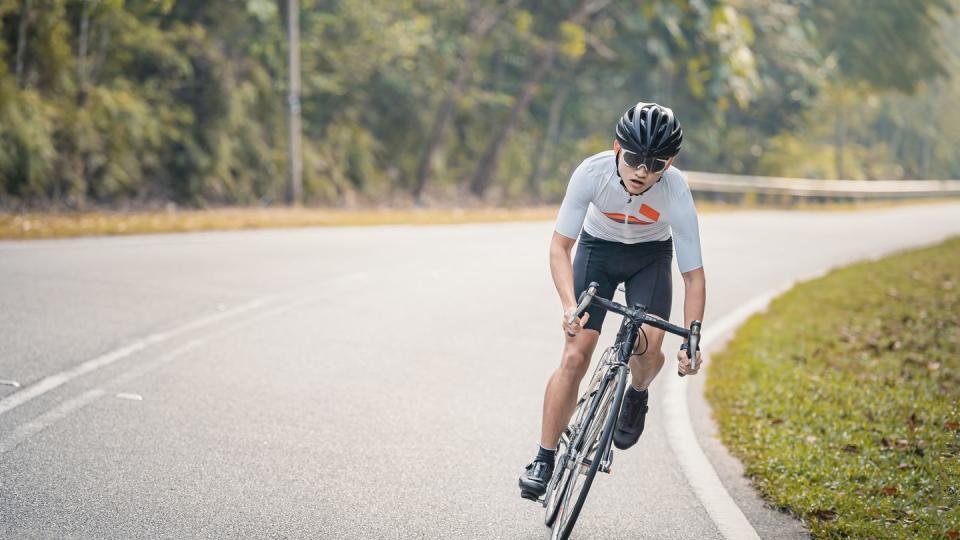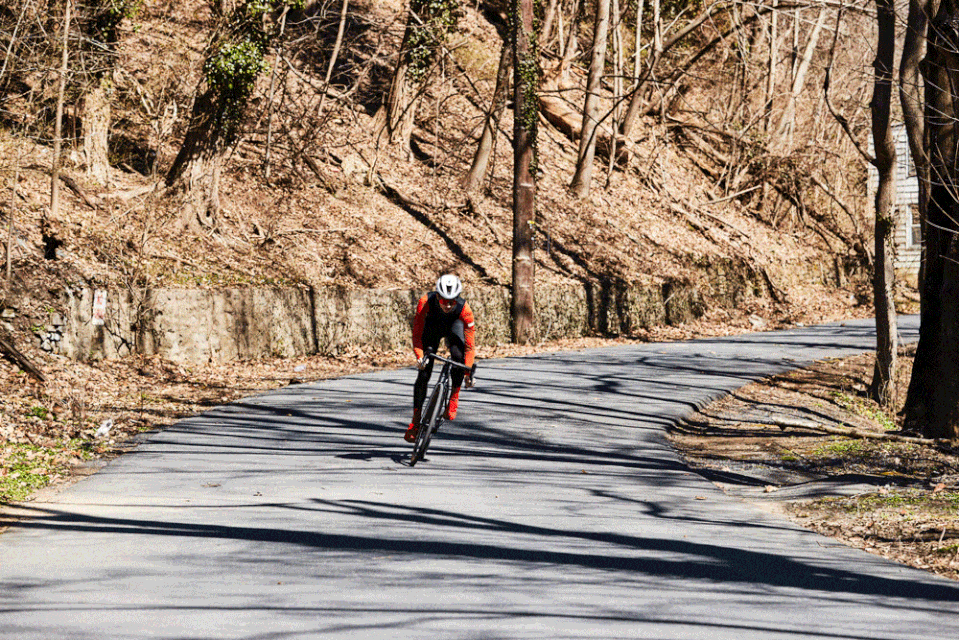7 Dos and Don’ts of Sprint Training

Sprinting on your bike is one of the foundational skills in cycling. It can also be one of the most intimidating, especially if you’re new to riding. But the exhilaration of pushing yourself as hard as you can to go as fast as you can is—simply stated—super fun. Putting the time in to learn how to sprint is well worth the effort and should have a spot on every cyclist’s skills bucket list.
“It’s a rush to go fast,” says Trevor Raab, Bicycling’s senior photographer who races cyclocross as a Cat 1. “In a race scenario it’s one of the biggest ‘highs’ you can get on a bike.”
For other riders, the transparent physicality and limit-pushing nature of sprinting is what they love most. “My favorite thing about sprinting is the feeling of going as fast as you physically can,” says Ashley Weaver, who rides for the U.S.-based pro cycling team LA Sweat.
Something to keep in mind when you’re first starting out with your sprints is that it truly is a skill that requires a focused practice and some dedication. Another thing to remember is that everyone was a beginner once. A perfect sprint isn’t something cyclists just automatically know how to do right out of the gate; it’s something that’s developed over time through consistency.
To help you zero in on this skill, we’ve compiled some of the crucial dos and don’ts of sprint cycling for riders who are learning sprint form for the first time and/or those who want to polish their sprint technique.
1. Do Learn to Ride Out of the Saddle and in the Drops
Riding in the drops (the lower, curved part of a road handlebar) puts you in a more aerodynamic and stable position when you’re going for maximum speed. So it’s crucial to get comfortable shifting and braking while in the drops. It may feel a little awkward at first if it’s new to you, but all it takes is practice for it to feel like second nature.
The next component to learn is how to rock your bike side to side while riding out of the saddle, as this allows you to deliver as much power as possible to each pedal stroke.
“When we lean the bike over, it’s to help with leverage on the side of the bike where you’re producing power,” Pan American Games gold medalist and cycling coach, Daniel Holloway explains.
While sprinting out of the saddle, the idea is to lean the bike (not your body) in the direction opposite your downstroke. This means that if you’re pushing down on the pedal on the left, you should lean your bike toward the right. The bike will be leaning in the opposite direction from the straight leg and in the direction of the leg at the top of the pedal stroke.

Create tension and stability while you do this by pulling on the handlebars, essentially using your bike as leverage. “Think about bringing the handlebars to your waist while pushing down on whichever is the forward leg,” says Holloway. “Then your foot’s coming over the top into the power and you’re going to pull the bike and push against the pedal and pull the handlebar towards you,” Holloway says.
2. Don’t Neglect Your Upper Body
Solid sprint form very much involves the upper body and core muscles, as well as the lower body. That means building strength in these areas is crucial to being able to ride powerfully. “Your core should be engaged [while sprinting]. Your shoulders should be engaged. And then there will be the natural inclination to start to rock [the bike],” Holloway says.
A strong upper body and core is also essential to the balance you need to shift your weight when you’re out of the saddle. Where you center your bodyweight will affect how you handle your bike, and Weaver recommends keeping your bodyweight and center of gravity shifted back over the bottom bracket.
“I struggled with repeatedly picking my back wheel up off the ground while I was sprinting,” she says, before she learned the importance of shifting weight back.
3. Do Shift Into the Right Gear
While starting with a heavy load when you’re first learning a move might seem counterintuitive—we often hear that we should master an exercise or technique before adding resistance—when it comes to learning how to sprint the opposite is true. Practicing in a harder gear, and therefore with heavier resistance to push against, will make the process of learning sprint form easier to practice.
“When you learn weightlifting form, you start light because you don’t want to injure yourself. But you also have to have some weight so you can feel the tension throughout the whole movement,” Holloway says. It’s the same with sprinting. “You’re going to be better off learning in a bigger gear and just practicing standing up and neurologically learning what it’s going to feel like under load.”
Noticing what your whole body does while sprinting and how everything works together synergistically is also part of the learning process. It’s easier to be mindful of those important subtleties when you’re working against resistance.
As for when you first start your sprint in something like a race setting, make sure you’re in the big ring in the front before you come out of the saddle. Any gear changes you make during the actual sprint should be happening in the rear, and it’s important not to push too heavy a gear too soon.
“A big tip is to start in an easier gear than you think you should,” Raab says. “Lots of people overgear when they’re trying to spin up.”
4. Do Practice, Practice, Practice
It’s impossible to overstate the importance of practicing your sprinting skills on a regular basis, and it’s not just about getting faster. A lot of the technical nuances of developing a good sprint are learned through firsthand experience, and then mastered by practicing enough for them to become muscle memory and feel automatic.
“Just like when you go pick up a 45-pound dumbbell. You’re going to set up your form, plant your feet right, and then as soon as you add tension, the neural pathway engages everything that needs to be engaged to get that weight off the ground. We’re doing the same thing, but on the bike,” Holloway says.
Dan Chabonov, Bicycling’s gear editor and former pro racer, says that practice is his biggest actionable tip for anyone learning how to sprint in cycling.
“I think the ‘genetic’ component of being a good sprinter is entirely overblown, especially for new riders,” he says. “It’s not zero, but practicing the actual mechanics of a sprint like timing your jump, knowing what gear to be in, and knowing when to shift are so much more important. These are things you only learn by doing a lot of practice sprints.”
5. Don’t Skip Training Sprints Outdoors
It’s possible to build a lot of the fitness needed to be a strong sprinter riding on an indoor trainer, and a lot of newer riders are more comfortable going all-out in a controlled environment instead of out on the road while they’re learning. However, it’s impossible to fully master sprints without practicing outdoors where your bike can rock side to side the way it should. And becoming comfortable with the side-to-side rocking movement of the bike when you’re out of the saddle is often one of the trickier things to learn.
“With sprinting, if you were to do it out of the saddle on the trainer, your bike is fixed. So trying to rock the bike is not possible,” Holloway says. “The body feels funky because you’re on a stationary thing and you’re only moving your body when ideally, you and your bike are [moving as] one.”
Finding the ideal place to train sprints outside is equally important for performance as it is for safety, and it’s best to avoid busy roads. “Find a safe stretch of road to practice on or an empty parking lot,” Raab says.
Once you’ve become comfortable with sprint form on a flat road, find a safe downhill and start practicing sprinting at higher speeds.
“Find a slightly downhill stretch of road or a downhill that goes into a flat where you can actually sprint at the speed you might be in a race,” Chabonov says. “Sprinting from 18 mph is much different than sprinting from 28 mph.”
6. Do Add Sprints to Your Everyday Rides
Sprint training doesn’t only have to take place within specific drills or workouts. Throwing sprints into your everyday rides is not only fun, it will help keep your skills and strength sharp. So much of sprint form is learned muscle memory, and as the adage goes: Use it or lose it.
“Sprint for town line signs on rides,” Chabonov recommends. “It’s fun and you can do it almost anywhere on any ride at any time. Include a sprint to finish your intervals. One way to do this would be to sprint for the last 10 seconds during 60-second intervals.”
Practicing your sprints with friends also comes with the added benefit of having someone to practice sprinting against, which can do wonders when working on getting faster too, according to Weaver.
7. Don’t Skimp on Strength Training
While practicing sprints in cycling and riding out of the saddle, you’ll also be able to identify areas where you’re weak, such as your upper body or core, and make the necessary tweaks to your strength-training routine to strengthen them. Doing so will make sprint form feel more fluid.
Weaver says one of the things that improved her sprint the most was a strength-training program. Slowing down and lifting weights is an integral part of developing good form on the bike in general, but this is especially true when aiming to build explosive power and perfect your out-of-the-saddle riding form.
Focus on total-body workouts in your strength plan, working not just your upper and lower body, but also your core. Incorporating plyometric moves like box jumps, skaters, burpees or lunge jumps will improve your muscular power on the bike, which will get you stronger for sprinting.
Don’t neglect to add exercises that improve your balance, too, such single-leg exercises and moves that incorporate a Bosu Ball or stability ball.
You Might Also Like

